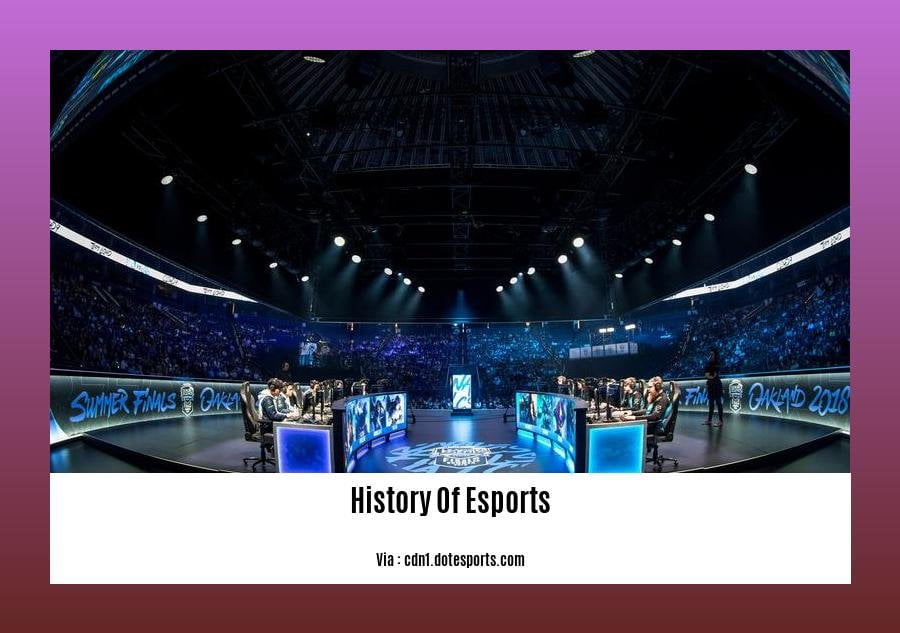
From Arcade Cabinets to Stadiums: A History of Esports Competitions
The evolution of esports, from humble beginnings in dimly lit arcades to sold-out stadiums and multi-million dollar prize pools, is a captivating story of technological advancement, passionate communities, and the relentless pursuit of competitive excellence. This journey, spanning several decades, has transformed video games from a solitary pastime to a global phenomenon, captivating millions and establishing itself as a legitimate and influential form of entertainment and sport.
The Dawn of Competition: The Arcade Era (1970s-1980s)
The seeds of esports were sown in the 1970s, even before the term itself existed. Early video game pioneers like Space Invaders and Pac-Man captivated audiences worldwide, fostering a competitive spirit among players. Arcades became vibrant hubs of competition, with players showcasing their skills against each other for bragging rights and, occasionally, small cash prizes. These informal gatherings, often characterized by high-score lists prominently displayed on arcade cabinets, represent the very genesis of esports. While organized tournaments were rare, the inherent competitiveness of these games laid the groundwork for the future. The emergence of Space Invaders championships, though rudimentary by today’s standards, showcased the burgeoning potential for competitive gaming.
The 1980s saw a rise in the popularity of fighting games like Street Fighter II. The ability to directly face off against another player, rather than simply chasing a high score, further amplified the competitive element. Local tournaments, often hosted by arcades themselves, became more common, fostering a sense of community and local rivalry. These events, though far from the polished productions we see today, were crucial in establishing the social and competitive aspects that would define esports. The emphasis was on local heroes and regional dominance, creating a foundation of grassroots competition that would later be expanded upon.
The Rise of LAN Parties and Early Online Tournaments (1990s-Early 2000s)
The advent of the internet in the 1990s revolutionized gaming and esports. Local Area Networks (LAN) parties became increasingly popular, bringing together players from wider geographical areas to compete in various games. These gatherings, often held in basements or rented spaces, fostered a strong sense of community and camaraderie, showcasing the social aspect integral to esports’ appeal. Early online tournaments, though hampered by limited bandwidth and technology, began to emerge, allowing players from across the globe to compete against each other.
Games like StarCraft, Quake, and Counter-Strike rose to prominence during this era, becoming foundational titles in the burgeoning esports landscape. These games, with their complex mechanics and strategic depth, attracted a dedicated player base who dedicated countless hours to honing their skills. The rise of dedicated gaming communities and forums further facilitated the organization of online tournaments and the growth of a competitive ecosystem. While prize pools remained relatively modest, the passion and dedication of the players were undeniable, paving the way for the professionalization of esports.
The Professionalization of Esports (Late 2000s-Present)
The late 2000s marked a turning point in the history of esports. Increased internet bandwidth, improved online infrastructure, and the rise of streaming platforms like Twitch and YouTube significantly amplified the visibility and reach of competitive gaming. Esports transitioned from a niche hobby to a rapidly expanding industry. Professional teams were formed, sponsorships poured in, and prize pools began to reach staggering amounts.
Games like League of Legends, Dota 2, Counter-Strike: Global Offensive, and Overwatch became global phenomena, attracting massive viewership and drawing in significant investment. Dedicated esports organizations emerged, providing players with salaries, coaching, and training facilities, further professionalizing the scene. The establishment of major leagues and tournaments, such as the League of Legends World Championship and The International (Dota 2), solidified esports’ status as a legitimate spectator sport.
The rise of mobile esports also contributed to the expansion of the industry, opening up competitive gaming to a broader audience. Games like Mobile Legends: Bang Bang and PUBG Mobile have garnered massive followings, particularly in Asia, creating new avenues for competition and viewership.
The Modern Esports Landscape: Global Reach and Continued Growth
Today, esports is a multi-billion dollar industry with a global reach. Professional players are celebrities, commanding significant salaries and endorsements. Major brands invest heavily in sponsorships, and stadiums are filled with enthusiastic fans watching electrifying competitions. Esports has become a significant part of the gaming landscape, attracting not only players but also investors, broadcasters, and brands.
However, the journey hasn’t been without challenges. Issues such as player burnout, fair play, and the need for better regulation and player welfare remain important considerations. The industry continues to evolve, seeking to address these challenges while striving to maintain the integrity and sustainability of the competitive ecosystem.
The future of esports looks bright, with continued technological advancements promising to enhance the viewing experience and broaden the appeal of competitive gaming. Virtual Reality (VR) and Augmented Reality (AR) technologies hold the potential to revolutionize esports, creating immersive and interactive experiences for both players and spectators. The ongoing integration of esports into mainstream culture, with increased media coverage and integration into traditional sporting events, suggests a bright future for this rapidly evolving industry.
From its humble beginnings in arcades to its current status as a global phenomenon, the history of esports competitions is a testament to the power of passion, technology, and community. The journey has been remarkable, and the future promises even greater innovation, growth, and excitement in the world of competitive gaming. The evolution of esports is a dynamic and captivating story that continues to unfold, shaping the future of entertainment and competition.



